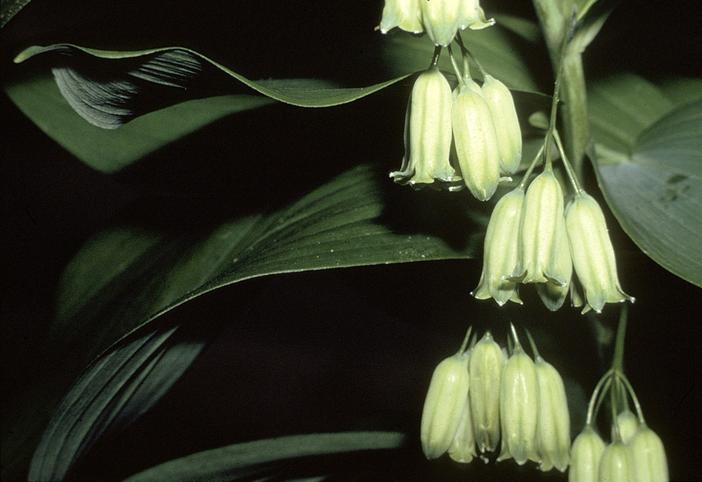Great Solomon’s Seal
(Polygonatum biflorum var. commutatum)
Great Solomon’s Seal (Polygonatum biflorum var. commutatum)
/
/

Robert H. Mohlenbrock. USDA NRCS
Public domain
Image By:
Robert H. Mohlenbrock. USDA NRCS
Recorded By:
Copyright:
Public domain
Copyright Notice:
Photo by: Robert H. Mohlenbrock. USDA NRCS | License Type: Public domain | License URL: https://creativecommons.org/public-domain/ | Uploader: Nonenmac | Publisher: Wikipedia Commons



























Estimated Native Range
Summary
Polygonatum biflorum var. commutatum, commonly known as the Great Solomon’s Seal, is a perennial herb native to rich, mesic deciduous forests, often found in the understory and along stream banks in the eastern United States. It typically grows between 1 and 3 feet tall with arching, unbranched stems. The leaves are alternate, ovate, and smooth-edged, creating a ladder-like appearance. In late spring to early summer, small, bell-shaped, white to greenish-white flowers dangle from the leaf axils, followed by blue-black berries in the fall. The flowers are modest yet attractive when observed up close, and the plant adds a graceful texture to woodland gardens.
Great Solomon’s Seal is valued for its arching form and the subtle beauty of its flowers, which are followed by ornamental berries. It is often used in shade gardens, naturalized woodland settings, and as an understory plant in larger landscapes. It prefers moist, well-drained soil rich in organic matter and thrives in part to full shade. While generally low-maintenance, it can be susceptible to slug damage and may require protection in areas with high slug populations. This plant is not typically invasive but can form dense colonies over time through rhizomatous spread.CC BY-SA 4.0
Great Solomon’s Seal is valued for its arching form and the subtle beauty of its flowers, which are followed by ornamental berries. It is often used in shade gardens, naturalized woodland settings, and as an understory plant in larger landscapes. It prefers moist, well-drained soil rich in organic matter and thrives in part to full shade. While generally low-maintenance, it can be susceptible to slug damage and may require protection in areas with high slug populations. This plant is not typically invasive but can form dense colonies over time through rhizomatous spread.CC BY-SA 4.0
Plant Description
- Plant Type: Herb
- Height: 2-3.9 feet
- Width: 1-2 feet
- Growth Rate: Slow
- Flower Color: White, Yellow
- Flowering Season: Spring, Summer
- Leaf Retention: Deciduous
Growth Requirements
- Sun: Part Shade, Full Shade
- Water: Medium
- Drainage: Medium
Common Uses
Bird Garden, Border Plant, Deer Resistant, Hummingbird Garden, Low Maintenance
Natural Habitat
Rich, mesic deciduous forests and stream banks in the eastern United States
Other Names
Common Names: Great Solomon’s Seal, Giant Solomon’s Seal, Smooth Solomon’s Seal
Scientific Names: , Polygonatum biflorum var. commutatum,
GBIF Accepted Name: